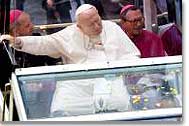 |
|
Llegada del Santa Padre a Pompeya, 7 de octubre de 2003 Arrival of the Pope at Pompeii, October 7, 2003 Ankunft des Heiligen Vaters in Valle di Pompei, 7. Oktober 2003 Foto: ANSA © 2003 |
|
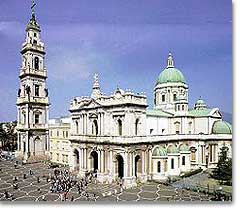 |
|
El Santuario de la Reina del Rosario, Pompeya The Shrine of the Queen of the Rosary, Pompeii Heiligtum der Rosenkranzkönigin, Valle di Pompei Foto: Secretariado del Santuario de Pompei |
|
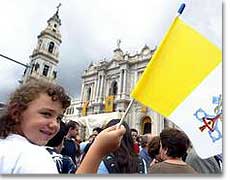 |
|
Bienvinida al Santo Padre en Pompeya Welcome to the Holy Father in Pompeii Willkommensgruß an den Heiligen Vater in Valle di Pompei |
|
 |
|
El Santo Padre hoy en Pompeya, rezando para la paz en Tierra Santa The Holy Father today in Pompeii, praying for peace in the Holy Land Der Heilige Vater heute in Pompei, im Gebet für Frieden im Heiligen Land Fotos: ANSA © 2003 |
|
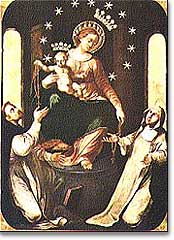 |
|
Virgen del Rosario, Pompeya Queen of the Rosary, Pompeii Gnadenbild von Valle di Pompei Foto: Secretariado del Santuario de Pompei |
|
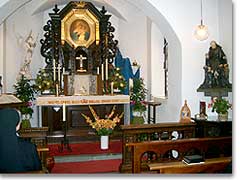 |
|
Santuario Original - oraciones para el Santo Padre en su peregrinación Original Shrine - prayers for the Holy Father and his pilgrimage Urheiligtum - Gebet für den Heiligen Vater und seine Pilgerfahrt Foto: POS Fischer © 2003 |
|
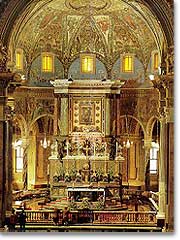 |
|
Interior del Santuario de Pompeya; el Padre Kentenich lo visitó en 1952 Interior of the Shrine in Pompeii; Fr. Kentenich visited it in 1952 Inneres des Heiligtums in Valle di Pompei; Pater Kentenich war 1952 dort Foto: Secretariado del Santuario de Pompei |
|
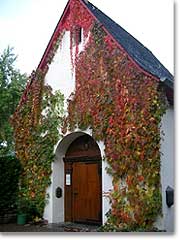 |
|
Un articulo sobre Pompeya - impulso "puerta abierta" para el Padre Kentenich en la fundación de Schoenstatt An article about Pompeii was a strong impulse for Father Kentenich on his way towards the founding of Schoenstatt Ein Artikel über Valle di Pompei war für Pater Kentenich eine "geöffnete Tür" auf dem Weg zum 18. Oktober 1914 Foto: POS Fischer © 2003 |
|
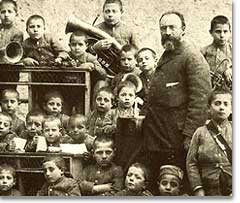 |
|
Bartolo Longo con huérfanos Bartolo Longo with orphans Bartolo Longo mit Waisenkindern Foto: Secretariado del Santuario de Pompei |
|
|
ROME, Fr. Alberto Eronti. Today, Tuesday, October 7, Pope John Paul II is realizing his long since announced pilgrimage to the Shrine of Our Lady of the Rosary, in Valle di Pompeii, Italy. This pilgrimage takes place in a particular context of world and church history. For the Schoenstatt Family, this pilgrimage of the Pope has a special meaning. His personal, intense devotion to Mary and to the Holy Rosary is expressed, in an original way, in the Schoenstatt Rosary Campaign. But the fact that he is on pilgrimage to Valle di Pompeii unites this devotion with Schoenstatt's pre-history. It was an article about Bartolo Longo and the Shrine in Valle di Pompeii that gave Father Kentenich the light on his road to the founding of Schoenstatt on October 18, 1914.
The armed violence sweeps the countries like a storm of hatred. The terrorist attacks not only move as such, but through the special way how they are performed: human bombs. A man or a woman blows up in order to kill, with him- or herself, a significant number of other human beings.
Praying the Rosary for Church and Humankind
Also the church is living through a special moment, not only as part of human history, but for the challenges that include the mission for the world, and the church's own life. A year ago, the Holy Father announced and opened the "Year of the Rosary and the Holy Virgin Mary". He did it, according to his own words, in view of the immense helplessness given the reality of the world, the church, and himself. From a deep experience of debility, he embraced the cross and turned his eyes to the supplicant omnipotence - Mary.
He prays to her, who passes on all graces, for the Church and for humankind. He prays to her that she gives us her heart, her thinking, her view, to search Christ with her and like her. It is about searching Christ in a special way, turning to an old means of prayer: the Holy Rosary. Praying the rosary unites with Mother and Child, what the Holy Father expresses as "contemplating Christ as the mysteries of the rosary present him." To this end he complemented the 15 traditional mysteries of the rosary with five other ones, thus achieving the totality of the life of Jesus of Nazareth, redeemer of humankind.
A special repercussion in the Schoenstatt family
Now, at the end of the "Year of the Rosary", his body marked by the cross of various illnesses, the Pope sets out on pilgrimage, maybe for the last time in his life of earth - and he pilgrims to Mary. He visits Our Lady of the Holy Rosary, in Valle di Pompeii. For our Schoenstatt Family, this gesture of the Pope has a special repercussion:
What the Pope lives and lived since a time, is called "Inscriptio" in our terms.
His intensive and personal devotion to Mary and the Holy Rosary is expressed, in an original way, in the Schoenstatt Rosary Campaign.
But the fact that he is on pilgrimage to Valle di Pompeii unites this devotion with Schoenstatt's pre-history. It was an article about Bartolo Longo and the Shrine in Valle di Pompei that gave Father Kentenich the light on his road to the founding of Schoenstatt on October 18, 1914.
From this perspective, the entire Schoenstatt family is called to spiritually be on pilgrimage with the Holy Father to the Shrine in Pompeii and give room to the words of the Holy Father. He goes to Pompeii as a gesture of love. It is his way to tell Mary, I love you, to show his love for the church, and teach the world what is the foundation of his hope.
The hour of love
Cardinal Ratzinger is right when he says that the Pope is not well. Others in his situation had long since ceased to work, expecting their Easter, their way homewards to the Father. Not the Pope. He has chosen to carry the cross and give to the church a unique and mysterious experience, only to be understood from love: the Pope is living to the hour of his deepest love, the love about that Jesus speaks in John 15,13. He is giving his life for those he loves. He is giving his life to Mary, in Pompeii, as supreme act of childlike love, to be "Totus tuus", her property and possession; he gives it to the church, showing thus that the cross of suffering is the bridge to the Father; he gives it to the world, living his faith and love (John 13,1) to the extreme. This October will be unique in the history of the Church. Unique because the Representative of Jesus Christ is living his identification with the Good Shepherd in a moving way, giving his life for his sheep (John 10,11).
High point of Fatherliness
Thinking about what I have written and been meditating these past days, I can't help remember the last months of the life of our Father. Also he was giving his life to us. He gave it to us at the high point of his fatherliness that is at the same time the peak of the cross. Spontaneously I would like to sing the song of my youth: "Let us ascend to be with Mary, let us love her at the peak of the cross, to be Fathers with her of a world that is to be born…" (Fathers of a new Kingdom, Chile). Indeed, the cross is the "peak", the high point of fatherliness. This is true for Jesus, for our Father, and now for the Holy Father.
Therefore, today, October 7, let us all spiritually pilgrim to Pompeii, let us be a crowd, united with the Pope, telling Mary that we love her and want to be her property and possession.
ACIprensa, the Latin American news agency, offers a complete coverage of the Pope's visit to Pompeii; additionally material about the history of Pompeii - with a large reference to Schoenstatt: ACIPRENSA